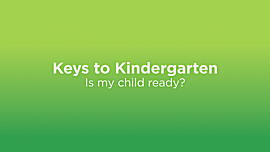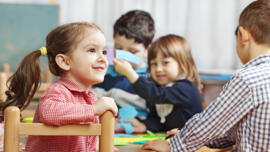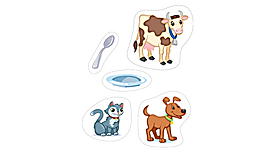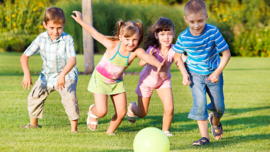Keys to Kindergarten: Social & emotional development
Keys to Kindergarten: Social & emotional development
3 ways to tell if your child is socially & emotionally ready for the next step
Kindergarten readiness doesn’t begin in preschool or even the summer before starting school. As parents and caregivers, you have helped your child prepare for the transition into school from the moment they were born. The games you play, conversations you have, and questions you answer have all had an impact. Here are three more ways to support your child’s social and emotional development before sending them to kindergarten. You may be surprised to find that you are already doing many of these things at home.
Develop empathy
Children are naturally self-centered. As they grow, they begin to notice things, people and emotions around them and they learn that different situations require different reactions. While most 5-year-olds know that they need to take turns and share, they really don’t want to because it doesn’t meet their needs. Developing empathy and being able to see another person’s point of view is a departure from self-centeredness and can be practiced at home. Parents will naturally model empathy for their children. Keep it up! It really does make a difference.
Ideas to try:
- Practice recognizing facial expressions with your child. Make a feelings book by taking pictures of family members with a variety of facial expressions. Ask your child, “How would your face and body look if you were angry, happy, sleepy…”
- Model empathy with your child. You can do this by saying, “Your brother is feeling sad because his friend couldn’t play today. What could we do to help cheer him up?” By modeling for young children that you identify with the feelings of another person, you are showing empathy.
- Ask your child to imagine how someone else feels. If your child is playing with a friend, point out, “You love jumping on the trampoline because you take gymnastics. Joey doesn’t take gymnastics and might not love it as much as you do. What do you think he would like to do?”
Help your child communicate his needs
Communicating needs can happen in a variety of ways in a kindergarten classroom. First and foremost, your child will need to be able to communicate basic needs to their teacher. They need to know that it’s ok to ask to use the bathroom, tell the teacher if they are not feeling well, or even ask for help if they aren’t sure about something. Some kids can do this easily, but others need a little extra boost in self-confidence to make that jump.
Being able to communicate needs to a friend or classmate is also essential but can be a challenge for young children. It can mean the difference fighting over a block and agreeing to work together to build something.
Learning to communicate needs takes practice, but there are many things you can do at home to help. Talk often with your child about your feelings, your child’s feelings, their friends’ feelings and how to best handle situations.
Ideas to try:
- Have your child practice using an I-Statement multiple times a day. “I feel sad when that happens. I’m feeling hungry. I don’t like it when you say that. I wanted the toy first and it makes me upset that he took it from me.” Even simple things like, communicating the need to use the bathroom or have help zipping a jacket, can be communicated with an I-Statement. The more your child practices verbalizing their needs, the better.
- Set up a stuffed animal school and have different animals practice asking for help or asking for permission to do something. Set up some simple conflicts with the stuffed animals and have your child help figure out what they can do to solve the problems. Some problems that happen often in a kindergarten classroom, between children, include taking turns, lining up, someone cutting in line, sharing supplies and materials, or kids not respecting someone’s personal space. Practice some of these scenarios and see if your child can solve a problem. This experience can help prepare for the real thing, if it should happen.
Follow adult rules and directions
Following adult rules, even if they don’t want to, can be a challenge for kids in the classroom. Kids need lots of practice and situations that help them learn to follow directions of other adults. For this, I can’t even begin to say enough about the importance of a good preschool or pre-K program. Preschool and pre-K allow children to become more independent. It’s a time to explore new ideas and curriculum, play and have fun, expand friendships, and learn to interact with adults other than family members. A quality early childhood program will help set the stage for years to come.
Beyond preschool, there are other things you can do at home to provide practice with these skills.
Ideas to try:
- As a kindergarten teacher, I have observed that kids whose parents treat them with respect, will generally act respectfully to an adult in charge in the classroom. Be that parent! Model respectful conversation and insist that respectful conversation and a respectful tone happen in your home. Make sure your child understands that the teachers, staff, and administrators have rules that kids need to follow to keep them safe and help them learn. Help them to know that you expect these rules to be followed as well.
- Many public libraries offer children’s programs. When my kids were preschool age, we had three local library programs offered on various days and times. I was able to choose the one that fit our schedule and needs the best. These programs are generally designed for a caregiver or parent to attend with the child. It’s not free childcare. During the story time, however, try to back off a bit. Let your child sit in the front row on their own. This is a great opportunity for your child to build independence and follow the directions of another adult.
- Local classes may offer another opportunity for adult interactions. If you are able to sign up for swim lessons, playtime at a gymnastics facility, or even preschool playtime at the local gym, your child will benefit from receiving instruction from someone other than Mom or Dad. Children begin to see adults in their community in the role of a teacher and will learn how to interact with those adults.
I always tell parents that they are their child’s first and best teacher. The example parents set for kids will set the tone for behavior, expectations and interactions. The opportunities that parents set up for kids will also prepare them for the social and emotional interactions that will come along in kindergarten. Conversations, questions, playtime with friends, and role play on a regular basis will help prepare young children for the challenges ahead of them. Kindergarten is an exciting time and you can help your child prepare socially and emotionally by practicing and playing in these ways.















